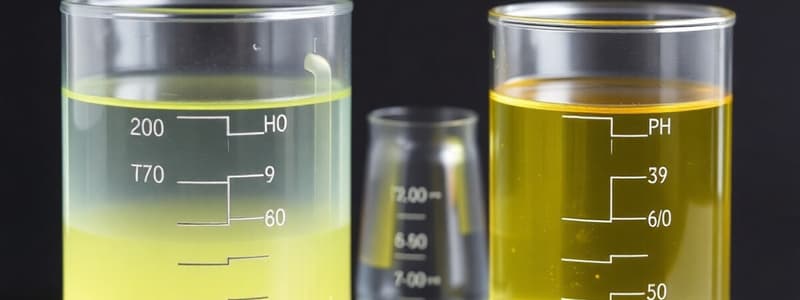Podcast
Questions and Answers
What are the initial concentrations of CH3COOH, CH3COO-, and H3O+ in a buffer solution that is 0.100 M CH3COOH and 0.100 M CH3COONa?
What are the initial concentrations of CH3COOH, CH3COO-, and H3O+ in a buffer solution that is 0.100 M CH3COOH and 0.100 M CH3COONa?
[CH3COOH] = 0.100 M, [CH3COO-] = 0.100 M, [H3O+] ≈ 0
Explain why the change in concentration of CH3COOH is represented as -x, while the change in concentration of CH3COO- is represented as +x, in the ICE table for the dissociation of CH3COOH. This is assuming that the reaction goes to the right.
Explain why the change in concentration of CH3COOH is represented as -x, while the change in concentration of CH3COO- is represented as +x, in the ICE table for the dissociation of CH3COOH. This is assuming that the reaction goes to the right.
The change in concentration of CH3COOH is negative because it is being consumed in the reaction. The change in concentration of CH3COO− is positive because it is being produced in the reaction.
In the ICE table, we assume that the initial concentration of H3O+ is approximately 0. Why is this assumption valid?
In the ICE table, we assume that the initial concentration of H3O+ is approximately 0. Why is this assumption valid?
The initial concentration of H3O+ is approximately 0 because the buffer solution is prepared from a weak acid and its conjugate base. The weak acid will only partially dissociate, resulting in a very low concentration of H3O+.
Write the equilibrium constant expression for the dissociation of CH3COOH.
Write the equilibrium constant expression for the dissociation of CH3COOH.
Explain how the value of Ka is used to determine the pH of a buffer solution.
Explain how the value of Ka is used to determine the pH of a buffer solution.
In the calculation of the pH of a buffer solution, the approximation that x is much less than [CH3COOH]i and [CH3COO-]i is often made. Explain why this approximation is valid for weak acids.
In the calculation of the pH of a buffer solution, the approximation that x is much less than [CH3COOH]i and [CH3COO-]i is often made. Explain why this approximation is valid for weak acids.
Why is it important to check if the approximation used in the calculation of the pH of a buffer solution is valid?
Why is it important to check if the approximation used in the calculation of the pH of a buffer solution is valid?
What is the relationship between [H3O+] and pH?
What is the relationship between [H3O+] and pH?
Explain how buffer solutions resist changes in pH when an acid or base is added to them. What is the chemical principle behind this resistance?
Explain how buffer solutions resist changes in pH when an acid or base is added to them. What is the chemical principle behind this resistance?
What is the common ion effect and how does it influence the pH of a buffer solution?
What is the common ion effect and how does it influence the pH of a buffer solution?
Explain how a buffer solution works by applying Le Chatelier’s Principle. Describe the chemical reactions that occur when a base or acid is added to the buffer solution.
Explain how a buffer solution works by applying Le Chatelier’s Principle. Describe the chemical reactions that occur when a base or acid is added to the buffer solution.
A solution contains 0.20 M acetic acid (CH3COOH, Ka = 1.8 x 10^-5) and 0.15 M sodium acetate (CH3COONa). Explain how this solution functions as a buffer.
A solution contains 0.20 M acetic acid (CH3COOH, Ka = 1.8 x 10^-5) and 0.15 M sodium acetate (CH3COONa). Explain how this solution functions as a buffer.
Describe how the pH of a buffer solution changes when a small amount of strong acid is added. How does this compare to the pH change if the same amount of acid is added to pure water?
Describe how the pH of a buffer solution changes when a small amount of strong acid is added. How does this compare to the pH change if the same amount of acid is added to pure water?
How would you prepare a buffer solution with a pH of 4.5 using a weak acid with a pKa of 4.0? Why would you want to maintain a pH of 4.5?
How would you prepare a buffer solution with a pH of 4.5 using a weak acid with a pKa of 4.0? Why would you want to maintain a pH of 4.5?
Explain why a buffer solution becomes less effective as the concentration of the weak acid or its conjugate base decreases.
Explain why a buffer solution becomes less effective as the concentration of the weak acid or its conjugate base decreases.
Describe the relationship between the pKa of a weak acid and the pH of a buffer solution. How does the pKa influence the buffer's effectiveness?
Describe the relationship between the pKa of a weak acid and the pH of a buffer solution. How does the pKa influence the buffer's effectiveness?
What is the purpose of a buffer solution in chemical reactions?
What is the purpose of a buffer solution in chemical reactions?
Explain the significance of the Henderson-Hasselbalch equation for basic buffers.
Explain the significance of the Henderson-Hasselbalch equation for basic buffers.
How do you calculate the pKa from the given pKb of a weak base?
How do you calculate the pKa from the given pKb of a weak base?
What components make up a basic buffer system?
What components make up a basic buffer system?
In the Henderson-Hasselbalch equation for a basic buffer, what do the variables represent?
In the Henderson-Hasselbalch equation for a basic buffer, what do the variables represent?
What happens to the pH of a buffer when an acid is added?
What happens to the pH of a buffer when an acid is added?
Describe the 'x is small' approximation in buffer chemistry.
Describe the 'x is small' approximation in buffer chemistry.
Why is it important to use weak acids and bases in buffer systems?
Why is it important to use weak acids and bases in buffer systems?
What is the pH of a buffer solution composed of 0.100 M CH3COOH and 0.100 M CH3COONa?
What is the pH of a buffer solution composed of 0.100 M CH3COOH and 0.100 M CH3COONa?
What role does the 'x is small' approximation play in applying the Henderson-Hasselbalch equation?
What role does the 'x is small' approximation play in applying the Henderson-Hasselbalch equation?
How can the pKa be derived from a given Ka value?
How can the pKa be derived from a given Ka value?
If a buffer solution has 0.050 M C6H5COOH and 0.150 M C6H5COONa, what is the pH?
If a buffer solution has 0.050 M C6H5COOH and 0.150 M C6H5COONa, what is the pH?
What conditions must be met to use the Henderson-Hasselbalch equation reliably?
What conditions must be met to use the Henderson-Hasselbalch equation reliably?
What initial values are used when calculating the pH of a buffer in equilibrium?
What initial values are used when calculating the pH of a buffer in equilibrium?
In the context of buffer solutions, what does Ka represent?
In the context of buffer solutions, what does Ka represent?
What is the significance of the Henderson-Hasselbalch equation in buffer calculations?
What is the significance of the Henderson-Hasselbalch equation in buffer calculations?
What is the first step needed to calculate the new pH after adding an acid to a buffer?
What is the first step needed to calculate the new pH after adding an acid to a buffer?
How does the addition of a base affect the components of a buffer?
How does the addition of a base affect the components of a buffer?
What defines the buffer capacity?
What defines the buffer capacity?
Why is the pKa value important when choosing an acid for a buffer?
Why is the pKa value important when choosing an acid for a buffer?
In a buffer designed for added acid, what is the expected relationship between the concentrations of [base] and [acid]?
In a buffer designed for added acid, what is the expected relationship between the concentrations of [base] and [acid]?
What makes a buffer effective within a specific pH range?
What makes a buffer effective within a specific pH range?
Calculate the ratio of NaCHO2 : HCHO2 required for a buffer with pH 4.25, given that HCHO2 has pKa of 3.74.
Calculate the ratio of NaCHO2 : HCHO2 required for a buffer with pH 4.25, given that HCHO2 has pKa of 3.74.
Which acid would be best to combine with its sodium salt for a buffer at pH 4.25: HClO2 (pKa 1.95), HNO2 (pKa 3.34), HCHO2 (pKa 3.74), or HClO (pKa 7.54)?
Which acid would be best to combine with its sodium salt for a buffer at pH 4.25: HClO2 (pKa 1.95), HNO2 (pKa 3.34), HCHO2 (pKa 3.74), or HClO (pKa 7.54)?
Flashcards
Common Ion Effect
Common Ion Effect
A phenomenon where the solubility of a salt is reduced due to the presence of a common ion.
Buffer Solution
Buffer Solution
A solution that resists changes in pH upon the addition of small amounts of acid or base.
Henderson-Hasselbalch Equation
Henderson-Hasselbalch Equation
An equation used to calculate the pH of a buffer from the pKa and concentrations of acid/base.
pKa
pKa
Signup and view all the flashcards
Initial Concentrations
Initial Concentrations
Signup and view all the flashcards
Equilibrium Concentrations
Equilibrium Concentrations
Signup and view all the flashcards
x is small approximation
x is small approximation
Signup and view all the flashcards
Calculating pH of a Buffer
Calculating pH of a Buffer
Signup and view all the flashcards
Le Châtelier’s Principle
Le Châtelier’s Principle
Signup and view all the flashcards
Weak Acid Equilibrium
Weak Acid Equilibrium
Signup and view all the flashcards
Adding Base to Buffer
Adding Base to Buffer
Signup and view all the flashcards
Adding Acid to Buffer
Adding Acid to Buffer
Signup and view all the flashcards
Buffer Effectiveness
Buffer Effectiveness
Signup and view all the flashcards
ICE Table
ICE Table
Signup and view all the flashcards
New pH calculation
New pH calculation
Signup and view all the flashcards
Buffer capacity
Buffer capacity
Signup and view all the flashcards
Buffer range
Buffer range
Signup and view all the flashcards
Choosing a buffer acid
Choosing a buffer acid
Signup and view all the flashcards
Reaction of added acid
Reaction of added acid
Signup and view all the flashcards
Reaction of added base
Reaction of added base
Signup and view all the flashcards
Ka (Acid Dissociation Constant)
Ka (Acid Dissociation Constant)
Signup and view all the flashcards
H3O+ Concentration
H3O+ Concentration
Signup and view all the flashcards
pH Calculation
pH Calculation
Signup and view all the flashcards
Change in Concentrations
Change in Concentrations
Signup and view all the flashcards
Approximation Validity
Approximation Validity
Signup and view all the flashcards
Substituting into Equations
Substituting into Equations
Signup and view all the flashcards
Basic Buffer
Basic Buffer
Signup and view all the flashcards
Weak Base
Weak Base
Signup and view all the flashcards
Conjugate Acid
Conjugate Acid
Signup and view all the flashcards
pKa and pKb Relationship
pKa and pKb Relationship
Signup and view all the flashcards
Concentration Assumption
Concentration Assumption
Signup and view all the flashcards
pH Change in Buffers
pH Change in Buffers
Signup and view all the flashcards
Study Notes
Buffer Solutions
- Buffers are solutions that resist small changes in pH when acid or base is added.
- Buffers work by neutralizing excess acid or base that is added to the solution.
- Blood contains a mixture of H₂CO₃ and HCO₃⁻.
- Pharmaceuticals and shampoo can be modified using buffers.
- Shampoo is a buffer of citric acid and NaOH.
- Buffers work by applying Le Châtelier's Principle to weak acid equilibrium.
- Buffers contain significant amounts of the weak acid molecules, HA.
- Weak acid molecules neutralize the added base.
- The H₃O⁺ combines with the OH⁻ to make H₂O, and H₃O⁺ is then replaced by the shifting equilibrium.
- The buffer solution also contains significant amounts of the conjugate base anion, A⁻.
- The conjugate base anion reacts with added acid to make HA.
- After the equilibrium shifts, the concentration of H₃O⁺ (H⁺) is kept constant.
- Adding a salt containing the anion, NaA, shifts equilibrium to the left, causing the pH to be higher than the pH of the acid solution.
Learning Objectives
- Calculate the pH of a buffer solution.
- Calculate the pH change when acid or base is added to a buffer solution.
- Specify the composition of a buffer solution with a given pH.
- Understand buffer "effectiveness".
Making a Buffer
- A buffer is made by mixing a weak acid and its conjugate base in solution.
How Acid Buffers Work: Adding Base
- Buffers contain significant amounts of the weak acid molecules, HA.
- These molecules react with added base to neutralize it.
How Acid Buffers Work: Adding Acid
- The buffer solution also contains significant amounts of the conjugate base anion, A⁻.
- These ions react with the added acid to make HA.
- The concentration of H₃O⁺(H⁺) is kept constant after equilibrium shifts.
Common Ion Effect
- Adding a salt containing the anion NaA (the common ion) shifts the position of equilibrium to the left, raising the pH of the acid solution.
- pH is higher than the acid alone.
Practice Problems (Example)
- Calculate the pH of a buffer that is 0.100M CH₃COOH and 0.100 M CH₃COONa.
- Initial concentrations of [HA] = 0.100, [A⁻] = 0.100, [H₃O⁺] = 0.
Henderson-Hasselbalch Equation
- Calculating the pH of a buffer solution can be simplified using the Henderson-Hasselbalch equation.
- The equation calculates the pH of a buffer using the pKa and initial concentrations of the weak acid and salt of the conjugate base.
- The equation is valid as long as the "x is small" approximation is valid.
Deriving the HH Equation
- Ka= [A⁻][H₃O⁺]/[HA]
- [H₃O⁺] = Ka[HA]/[A⁻]
Do I Use the Full Analysis or HH?
- The Henderson-Hasselbalch equation is helpful for approximating the pH of a buffer when the initial acid and salt concentrations are over 100x-1000x the value of Ka.
Example Problems
- Calculate the pH of a buffer that is 0.050 M C₆H₅COOH and 0.150 M C₆H₅COONa.
Practice Problems (Example)
- Calculate the pH of a buffer that is 0.14 M HF (Ka= 7.08 x 10⁻⁴) and 0.071M KF.
Basic Buffers
- Buffers can be formed from mixing a weak base and a soluble salt of its conjugate acid.
HH Equation for Basic Buffers
- The Henderson-Hasselbalch equation can be used to calculate the pH or pOH of a basic buffer solution.
- Equation is rewritten in terms of pOH.
Relationship between pKa and pKb
- There's a relationship between the pKa of a weak acid and the pKb of its conjugate base.
Example Problems
- What is the pH of a buffer that is 0.50 M NH₃ (pKb = 4.75) and 0.20 M NH₄Cl?
Effectiveness of Buffers
- A good buffer can neutralize moderate amounts of added acid or base.
- Buffer capacity is the amount of acid or base that can be added without causing a large change in pH.
- The buffer range is a useful measurement for buffer effectiveness.
Buffer Capacity
- Buffer capacity is the amount of acid or base that can be added to a buffer without causing a large change in pH.
- Buffers intended to work with added acid have a generally higher [base] than [acid].
- Buffers intended to work with added base have a generally higher [acid] than [base].
Buffer Range
- A buffer is most effective when the pH is close to its pKa. The maximum and minimum effective pH can be calculated.
Practice Problems
- Which acid is best to combine with its sodium salt to create a buffer with pH 4.25 given a list of different acids?
- Calculate the ratio of NaCHO₂ to HCHO₂ for a buffer with pH 4.25.
Studying That Suits You
Use AI to generate personalized quizzes and flashcards to suit your learning preferences.




